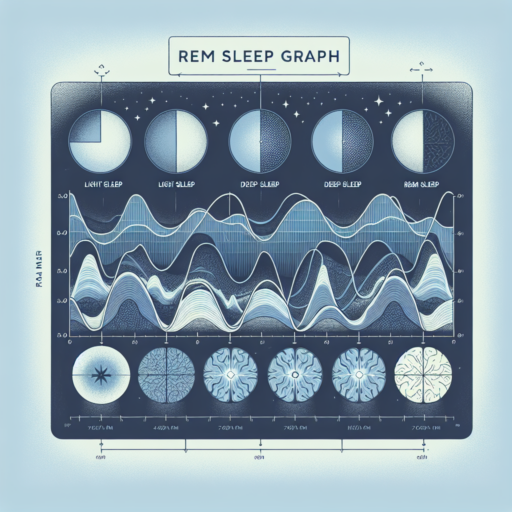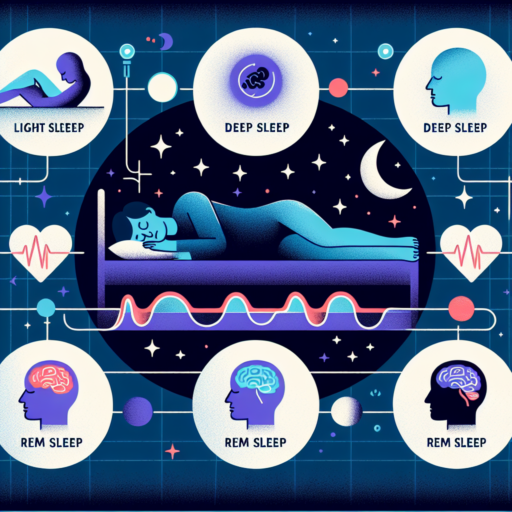Understanding Lighter Sleep Cycles and Their Importance
Exploring the intricacies of lighter sleep cycles is pivotal in comprehending our sleep patterns and their impacts on our daily lives. Unlike deep sleep stages, lighter sleep cycles, often referred to as the non-REM (Rapid Eye Movement) stages 1 and 2, play a crucial role in mental restoration and memory consolidation. This phase acts as a bridge between wakefulness and deep sleep, preparing the body for the restorative sleep stages that follow.
Lighter sleep cycles are characterized by a decrease in heart rate, breathing rate, and muscle activity. Although this stage is easier to wake from, its significance cannot be understated. During these initial phases of sleep, your brain sifts through the day’s information, deciding what to store as long-term memory and what to discard. This process not only enhances learning and memory but also supports emotional and mental health.
Incorporating behaviors that promote a healthy sleep cycle, including lighter sleep stages, can lead to improved cognitive function and overall well-being. Understanding the characteristics and importance of these initial sleep stages empowers individuals to make informed decisions about their sleep habits. This might include establishing a consistent bedtime routine, reducing blue light exposure before bedtime, and creating a sleep-conducive environment.
The Science Behind Lighter Sleep Cycles
Understanding the science behind lighter sleep cycles is crucial for recognizing how our bodies operate on a fundamental level during rest. This phase of sleep, known more formally as the non-REM (Rapid Eye Movement) Stage 1, acts as the bridge between wakefulness and deeper sleep stages. It is in this initial phase that the body begins to slow down both its physical and mental processes, preparing itself for the restorative sleep stages that follow.
During lighter sleep cycles, the brain emits what are known as theta waves, a type of brainwave activity that signifies reduced consciousness. At this juncture, individuals may experience what is often referred to as a hypnagogic state, where one is neither fully awake nor completely asleep. This transitionary period is marked by brief periods of muscle twitching, a phenomenon that many report along with the sensation of falling, leading to sudden jerks that may awaken them momentarily.
Research into the characteristics of lighter sleep cycles has highlighted their importance in the overall sleep architecture. While these moments may seem fleeting and of lesser significance compared to deeper sleep stages like REM or Slow Wave Sleep (SWS), they play a vital role in easing the transition into these more restorative phases. Understanding these cycles better can help illuminate strategies for improving sleep quality, emphasizing how essential it is to consider the full spectrum of sleep beyond merely quantifying its duration.
How Lighter Sleep Cycles Impact Your Health
Understanding the importance of sleep is crucial in maintaining a healthy lifestyle. However, not all sleep is created equal. Lighter sleep cycles, although often overlooked, play a significant role in our overall health and well-being. These stages of sleep, primarily consisting of stages 1 and 2 of the non-REM cycle, may seem inconsequential but have profound impacts on our cognitive functions and physical health.
During the lighter phases of sleep, our bodies undergo a period of slight relaxation, where heart rate and breathing slow down, but we are not yet in deep sleep. This stage is easily disrupted, leading to significant repercussions on our health. Firstly, it affects our cognitive abilities, including memory consolidation, learning, and processing of information. Frequent interruptions in lighter sleep cycles can lead to decreased concentration and memory retention, making daily tasks more challenging.
Moreover, the impact on physical health cannot be understated. Lighter sleep cycles contribute to the regulation of important hormones responsible for growth and appetite. Disruption in these cycles can lead to an imbalance in hormone levels, affecting appetite control, weight management, and even the risk of developing chronic conditions such as diabetes and heart disease. Furthermore, inadequate lighter sleep phases can compromise the immune system, making individuals more susceptible to infections and illnesses.
Identifying If You’re Experiencing Lighter Sleep Cycles
Identifying if you’re experiencing lighter sleep cycles can be crucial for understanding your overall sleep quality. These cycles, known as Non-REM Stage 1 and Stage 2, are the initial phases of sleep, where the transition from wakefulness to sleep occurs. Signs that indicate you might be spending more time in these lighter sleep stages include frequently waking up at night, feeling tired despite a full night’s sleep, and having vivid memories of dreams right after falling asleep.
It’s also essential to be aware of the factors that could contribute to lighter sleep cycles. Stress, anxiety, and lifestyle habits such as late-night screen time can significantly impact the depth of your sleep. Moreover, environmental disturbances like noise or an uncomfortable mattress can prevent you from reaching the deeper, more restorative sleep stages. Recognizing these signs and contributors can be the first step toward improving your sleep health.
Tools and methods for monitoring your sleep patterns, such as wearable sleep trackers or apps, can offer valuable insights into how much time you’re spending in each sleep stage. These technologies typically use movement and heart rate data to estimate the depth of sleep. Tracking this over time can help you identify trends or changes in your sleep cycles, giving you the chance to make informed adjustments to your sleep habits.
Improving Your Sleep Quality: Tips for Navigating Lighter Sleep Cycles
Navigating through lighter sleep cycles can often feel like trying to walk through a labyrinth in the dark. But understanding the rhythm of your sleep and employing targeted strategies can remarkably enhance your sleep quality. Since lighter sleep stages are integral to our sleep architecture, finding ways to smoothly transition and improve the experience within these phases is crucial for overall well-being.
One of the first steps in navigating lighter sleep cycles is to establish a consistent sleep schedule. Going to bed and waking up at the same times every day, even on weekends, helps regulate your body’s internal clock. This regularity makes falling asleep and moving through light and deep sleep cycles much more seamless.
Strategies to Enhance Sleep During Lighter Cycles
- Avoid Stimulants: Limiting the intake of caffeine and nicotine close to bedtime can prevent your body from staying in lighter stages of sleep for too long.
- Optimize Your Sleep Environment: Ensure your bedroom is conducive to sleep—this means cool, dark, and quiet. Consider using blackout curtains and white noise machines to create an ideal sleeping atmosphere.
- Limit Screen Time: Exposure to blue light from screens can interfere with your circadian rhythm. Try to avoid electronic devices at least an hour before bedtime to enhance your sleep quality.
By focusing on these areas, anyone can take control of their lighter sleep cycles, turning what might have seemed like a disadvantage into a beneficial part of their sleep architecture. Engaging in routines that signal to your body it’s time to wind down can make a significant difference in how you experience light sleep stages, setting the stage for rejuvenation and health.
Common Myths and Facts About Lighter Sleep Cycles
Understanding the complexities of sleep involves debunking the myriad of myths surrounding lighter sleep cycles. These cycles, often overshadowed by a focus on deep sleep, play an integral role in our sleep architecture. In exploring these misconceptions, we shed light on the factual aspects that can lead to improved sleep health.
Myth: Lighter Sleep Cycles Don’t Contribute to Rest
One prevalent myth is the belief that lighter sleep cycles, such as stages 1 and 2 of non-REM sleep, do not significantly contribute to feeling rested. In fact, these stages serve crucial functions in cognitive processing and memory consolidation. Dismissing their importance can lead to a misunderstanding of how to optimize sleep for mental and physical well-being.
Fact: Variation in Sleep Cycles is Normal
A critical fact to acknowledge is the variation in sleep cycle patterns among individuals. The assumption that every healthy adult follows a textbook progression through sleep stages overlooks the natural diversity in sleep architecture. Recognizing this variation can alleviate concerns about lighter phases of sleep and emphasize their normalcy within the sleep cycle.
Moreover, the role of lighter sleep cycles extends beyond mere placeholders in the night. These stages act as transitions and can be influential in determining the overall quality of sleep. By understanding the myths and facts about lighter sleep cycles, individuals can adopt a more forgiving and informed perspective on the nuances of their sleep patterns.
The Role of Diet and Exercise in Managing Lighter Sleep Cycles
Understanding the vital role of diet and exercise in managing lighter sleep cycles is essential for anyone looking to improve the quality of their sleep. Research has consistently shown that what we eat and how much we move during the day can significantly impact our sleep patterns, especially when it comes to experiencing lighter or more fragmented sleep. Incorporating certain dietary habits and exercise routines into our daily lives can be a game-changer for those struggling to achieve restorative sleep.
Impact of Diet on Sleep Quality
Eating habits play a crucial role in determining the quality of our sleep cycles. Consuming a diet rich in fruits, vegetables, and whole grains can promote a better sleep pattern. Specifically, foods containing magnesium, potassium, and tryptophan have been linked to improvements in the length and quality of sleep. Conversely, high intake of sugary snacks, caffeine, and heavy meals close to bedtime can contribute to lighter and more disrupted sleep cycles, preventing the deep, restorative stages of sleep.
Exercise as a Catalyst for Deeper Sleep
Regular physical activity is another pillar in managing lighter sleep cycles effectively. Engaging in moderate aerobic exercises, such as walking or cycling, can significantly enhance the depth and quality of sleep by promoting the increase of slow-wave sleep, the deepest phase of non-REM sleep. It’s not only about intensity; consistency in exercise timing can also regulate the body’s internal clock, leading to improvements in sleep onset and continuity. However, it’s important to avoid vigorous workouts close to bedtime, as they may have the opposite effect, increasing alertness and delaying sleep.
Technological Advances for Monitoring and Enhancing Lighter Sleep Cycles
In the quest for improved sleep quality, significant strides have been made in the realm of technology, particularly concerning the monitoring and enhancing of lighter sleep cycles. This area of focus has garnered attention because lighter sleep stages are pivotal for both physical and mental restoration. Modern innovations are not only aimed at identifying these crucial sleep cycles but also at enhancing them to promote overall wellness.
One of the most notable advancements is the development of sleep trackers and wearable devices. These gadgets utilize cutting-edge sensors to provide users with detailed insights into their sleep patterns, including the duration and quality of their lighter sleep stages. With this data, individuals can make informed adjustments to their sleep habits, environments, or routines to optimize their lighter sleep cycles. Moreover, many of these devices come equipped with features designed to directly enhance sleep quality, such as gentle vibrations that guide the user back to optimal sleep stages without fully awakening them.
Another groundbreaking development is the use of smart home technology to create an ideal sleeping environment. Innovations such as smart thermostats and lighting systems adjust the bedroom’s temperature and lighting to mimic natural sleep-wake cycles, thus promoting lighter sleep cycles. These technologies are rooted in the principle of circadian rhythm, ensuring that environmental cues support the body’s internal clock and facilitate smoother transitions between different sleep stages.
No se han encontrado productos.
Case Studies: Real-Life Improvements After Addressing Lighter Sleep Cycles
Exploring the impact of addressing lighter sleep cycles offers fascinating insights into the potential for enhancing overall well-being and productivity. Numerous case studies have demonstrated significant improvements in a range of areas, from increased energy levels to better mental health, by focusing on this critical aspect of rest. Understanding the nuances of these sleep cycles and implementing changes can lead to profound, life-altering benefits.
Improved Cognitive Functions: One of the most immediate benefits observed in individuals who have optimized their lighter sleep cycles is enhanced cognitive performance. This includes sharper memory recall, improved concentration, and quicker problem-solving abilities. By ensuring that lighter sleep cycles are not disrupted, individuals wake up feeling more refreshed and ready to tackle their daily tasks with greater efficiency.
Enhanced Emotional Well-Being: Adjusting sleep patterns to better accommodate lighter sleep cycles has also shown to have a positive impact on emotional health. Participants in various case studies reported feeling less prone to mood swings, reduced anxiety, and a noticeable decrease in symptoms of depression. The correlation between better sleep and improved emotional well-being underscores the importance of addressing sleep quality in our daily lives.
- Fosters a positive outlook on life
- Reduces the likelihood of emotional fatigue
- Improves resilience against stress
Future Trends in Research and Management of Lighter Sleep Cycles
Sure, here is an SEO-focused content based on your specifications:
The exploration of lighter sleep cycles has gained remarkable attention in the realm of sleep research and management, reflecting a growing curiosity about how these sleep stages affect overall health and well-being. As we navigate further into the 21st century, several innovative trends are shaping the outlook of this fascinating field.
Technological advancements stand at the forefront of these emerging trends. Wearable devices and mobile applications are becoming increasingly sophisticated, offering detailed insights into sleep patterns, including the duration and quality of lighter sleep cycles. This surge in personal sleep tracking technologies is not merely a fad but represents a significant shift towards personalized sleep management strategies. By leveraging these tools, individuals can gain a deeper understanding of their sleep behavior, enabling tailored interventions that could enhance their quality of life.
Integration of AI and Machine Learning in Sleep Research
Another groundbreaking development is the integration of Artificial Intelligence (AI) and machine learning into sleep research. These technologies are revolutionizing the way researchers analyze sleep data, predict sleep disorders, and customize treatment plans. By meticulously analyzing vast amounts of sleep data, AI algorithms can identify patterns and anomalies in lighter sleep cycles, offering unprecedented insights into individual and population-level sleep health trends.
This trajectory points toward a future where managing lighter sleep cycles becomes a more nuanced and data-driven practice. As research continues to unveil the complexity and importance of these cycles, the potential for targeted interventions and therapies grows, promising a new era in sleep medicine that emphasizes prevention, personalization, and precision.




